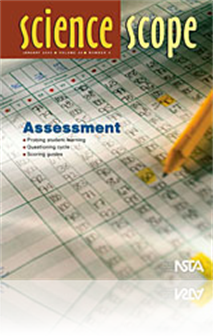All Science Scope resources
Journal Article
Spill Sleuths: An Interdisciplinary Environmental Health Investigation
An environmental health mystery can help teach students many aspects of environmental health and crisis management in the context of their own community. Students use skills from several disciplines to pinpoint, assess, and address the environmental ...
Journal Article
Science Sampler: Strategies to increase active discussion and thinking for all students
How many times have you expected to hold an exciting class discussion after a laboratory activity or demonstration only to have just one or two students speak? To increase student participation in class discussions, try using the three instructional ...
Journal Article
If only Humpty-Dumpty had known about the egg bungee jump... This engaging activity helps students experience science in a constructivist, inquiry-oriented manner and has the added benefit of providing a concrete context within which students can ex...
Journal Article
Science Sampler: Formative assessment guideposts
A formative assessment can provide a snapshot of what a student knows and is able to do. Use this approach to close the gap between what is known and what needs to be known through informative feedback. Explore the use of formative assessments with n...
Journal Article
After the bell: Mapping your way to geographic awareness: Part II
Students experience, through simulation, the skills that are required of a cartographer in this activity that integrates literature, history, and science. Students will discover how the technique of mapmaking has evolved over time and how the style o...
Journal Article
Linking Classroom Instruction and Assessment to Standardized Testing
Is it possible to "teach to the test" and still include inquiry-based science in your classroom? Yes! By using the model presented in this article that shows how inquiry-based instruction and creative classroom assessment can be used to teach concept...
Journal Article
Editor's Roundtable: Where are we now? (January 2005)
Trends in Mathematics and Science Study (TIMSS) and the Program for International Student Assessment (PISA), two major international studies of achievement in science and mathematics, provide insights and an opportunity to increase students' science ...
Journal Article
Popping the Kernel: Modeling the States of Matter
Constructing models can help students understand the particulate nature of matter. This article discusses how to use popcorn to engage students in model building and to teach them about the nature of matter. ...
Journal Article
Science Sampler: Pictures in the sky
This "stellar" project helps students think in both two and three dimensions, displays the relative distances between the Earth and stars, and introduces students to the constellation myths of diverse cultures....
Journal Article
Tried and true: Feeding of Diarmis Proboscis
The feeding of Diarmis proboscis is an exciting outdoor laboratory activity that demonstrates a single concept of adaptations--cryptic colorations. The students are “transformed” into D. proboscis in order to learn how adaptations work in the n...
Journal Article
Questioning Cycle: Making Students' Thinking Explicit During Scientific Inquiry
Are you thinking about ways to get your students to think about science? Inquiry learning is an excellent way for students to get actively involved in science. Use the informative questioning cycle described in this article to ensure that students ar...
Journal Article
Scope on the Skies: January in the skies
Celestial events abound during the month of January, ranging from a potentially bright comet, visible planets in both the morning and evening skies, and the Huygens probe descent into the atmosphere of Saturn's moon, Titan. Reach for the stars this m...



